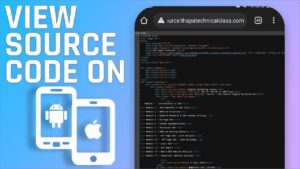For anyone interested in web development or even just curious about the structure of websites, the concept of view-source is an incredibly valuable tool. If you’ve come across the term view-source:https://roobx4uuu., you might wonder what it means, how it works, and why it’s useful. This blog post unpacks everything you need to know about view-source, its purpose, benefits, risks, and the ethical considerations around using this feature.
Understanding view-source
At its core, view-source is a command used in web browsers that allows users to see the underlying HTML code of a webpage. This feature is easy to use—you simply prefix a URL with view-source: and input it into the browser’s address bar. The result is the raw HTML, CSS, and JavaScript that make up the page’s visual and functional elements.
Example:
If you type view-source:https://roobx4uuu. in your browser’s address bar, the browser will take you to a read-only version of the HTML source code for the https://roobx4uuu.blogspot.com page. This gives a look behind the scenes at how the page was built.
How It Works
- Viewing Raw Code: Browsers render web pages using a combination of HTML, CSS, and JavaScript. When you use the
view-sourcecommand, the browser displays this raw code instead of the visual web page. - Read-Only Access: The source code is displayed as plain text, meaning you can view the structure and elements but cannot alter them.
- Supported Browsers:
-
- Chrome
- Firefox
- Opera
- Microsoft Edge
- Brave
There’s no special software or download required—this functionality is built directly into modern web browsers.
The Benefits of view-source
view-source serves multiple purposes beyond simple curiosity. Below are some groups who benefit the most from this feature:
1. For Developers and Designers
-
- Debugging: The
view-sourcecommand is a lifesaver when it comes to troubleshooting design and functionality issues. Developers can inspect their code for errors or study how scripts behave. - Learning: Beginners often use
view-sourceto study how professional websites structure their HTML, CSS, and JavaScript. - Code Inspiration: Designers can learn new techniques by analyzing how visual elements are coded.
- Debugging: The
2. For SEO Specialists
-
- Analyzing Meta Tags: Viewing the source reveals meta descriptions, title tags, and schema markup that are critical for SEO.
- Understanding Keyword Usage: SEO pros can study how keywords are distributed within a competitor’s content or attributes.
3. For Writers and Digital Marketers
-
- Content Annotations: The source code may reveal structured data or embedded microformats, useful for tracking how content is indexed by search engines.
4. For Educators
Educators can use view-source as an interactive teaching tool. By stripping away the visual interface and looking at the raw elements, students can learn the building blocks of web development firsthand.

Quick Benefits Table
|
Audience |
Use Case |
Benefits |
|---|---|---|
|
Developers |
Debugging, learning new techniques |
Improves code quality and skills |
|
SEO Professionals |
Analyzing meta-data, keyword density |
Enhances search rankings optimization |
|
Beginners |
Studying basic HTML |
Gain insight into page layouts |
|
Writers/Content Creators |
Analyzing structured data |
Better understand how articles are indexed |
Risks of Using view-source
Although view-source is a relatively safe tool, there are potential risks and challenges to be aware of:
1. Misinterpretation
HTML and CSS can appear daunting at first glance, especially for beginners. Those unfamiliar with web development may misinterpret code and make incorrect assumptions.
2. Privacy Concerns
Web developers may unintentionally include sensitive information, such as private API keys or email addresses, in the page’s source code. While this is considered bad practice, someone viewing the source might discover such data.
3. Exploitation
Malicious actors could misuse publicly visible scripts or metadata for unethical purposes, such as data scraping or phishing.
4. Outdated Information
Some websites use dynamic rendering technologies where the initial HTML serves as a placeholder. The view-source result might not reveal the full picture of how the page functions.
Ethical Considerations
Using view-source ethically is as important as understanding its functionality. Below are key principles to keep in mind:
1. Respect Copyright
Do not copy or reuse code without the creator’s consent. The HTML and CSS code is protected by copyright laws, even if it’s accessible.
2. Transparency Over Exploitation
Use view-source for educational purposes, troubleshooting, and self-improvement—not to undermine the work of others or steal intellectual property.
3. Respect Privacy
Avoid mining sensitive or personal data from the HTML source. Developers sometimes leave contact information or other private data embedded in the code, assuming it won’t be easily discovered.
Best Practices for Ethical Use:
- Always attribute inspiration to source sites.
- Never scrape sensitive data or bypass security measures.
- Use tools like
view-sourcefor positive, educational purposes.
How to Access view-source Step-by-Step
- Open your browser.
- Enter
view-source:followed by your desired URL (e.g.,view-source:https://roobx4uuu.).blogspot.com - Press “Enter.” The browser will display the page’s source code.
- Optional: Use
Ctrl + F(Windows) orCmd + F(Mac) to search for specific tags or attributes within the source code.
Advanced Tip
Most browsers include built-in developer tools that serve as a more sophisticated extension of view-source. Simply right-click on the webpage, select “Inspect,” and you’ll gain access to advanced features like DOM manipulation, performance evaluation, and debugging.

The Takeaway
By using view-source, you gain valuable insights into the structure and working mechanisms of any webpage, whether it’s a personal blog such as https://roobx4uuu.blogspot.com or a major corporate site. While the tool is simple, its applications for developers, designers, SEO specialists, and educators are immense.
However, it’s crucial to use this tool responsibly. Misusing source code for unethical purposes undermines the principle of transparency that the web was built upon.
For readers who want to learn more about improving their web skills or exploring current trends in technology and design, check out our resources at TrendsMag. Whether you’re a beginner or a seasoned pro, there’s always more to discover in the world of digital development.
Final Word
Understanding view-source and leveraging it for ethical and practical purposes bridges the gap between curiosity and learning. Whether you’re debugging code, analyzing SEO, or just exploring how websites work, this browser feature is a powerful gateway to knowledge.
By using the tools and tips shared here, you can take your skills to the next level—without compromising on ethics or respect for the work of others. Start experimenting today!




